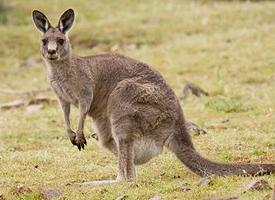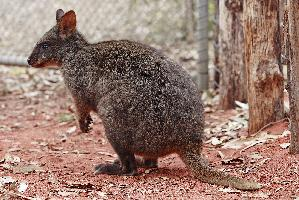
Weights and measures
| Length | from 52 to 68 cm |
|---|---|
| Weight | from 4 to 10 kg |
Animal description
The Tammar wallaby (Notamacropus eugenii), also known as the dama wallaby or darma wallaby, is a small to medium-sized marsupial native to parts of Australia and introduced to New Zealand. This fascinating creature is a member of the kangaroo family and exhibits several unique features and behaviors that set it apart from other marsupials.Physical Characteristics:
The Tammar wallaby is distinguishable by its compact, muscular build, and typically measures about 59 to 68 cm in body length, with a tail length approximately equal to its body length. Males are generally larger than females. They possess a coarse fur that ranges in color from grey to brown, with a lighter underbelly. One of the most distinctive features of the Tammar wallaby is its powerful hind legs, which are adapted for jumping at high speeds and covering significant distances in a single bound. They also have a long, strong tail that aids in balance and maneuverability.
Habitat and Distribution:
Originally found across several regions in South and Western Australia, the Tammar wallaby's natural habitat has significantly declined due to habitat destruction and predation. They thrive in scrublands and dense vegetation, which provide both food and shelter from predators. Notably, small populations have been introduced to New Zealand and various islands, where they have adapted well to local conditions.
Diet and Feeding Habits:
The Tammar wallaby is primarily nocturnal, venturing out at night to feed on a variety of grasses, leaves, and occasionally, fruits. They have a specialized stomach that allows for efficient digestion of tough plant material, a common trait among kangaroos and wallabies. This marsupial is known for its ability to conserve water efficiently, a crucial adaptation for survival in the arid regions of Australia.
Reproductive Behavior:
One of the most remarkable aspects of the Tammar wallaby's biology is its reproductive system. Females have the ability to engage in embryonic diapause, a condition where the development of the embryo is temporarily halted until environmental conditions are favorable. This ensures that the offspring are born at a time when resources are plentiful. The gestation period is about 26 days, one of the shortest among mammals. After birth, the joey crawls into its mother's pouch, where it will continue to develop and nurse for several months.
Conservation Status:
The Tammar wallaby has faced significant threats from habitat loss, predation by introduced species like foxes and cats, and competition for food with livestock. Despite these challenges, conservation efforts, including habitat restoration and predator control, have helped stabilize some populations. The Tammar wallaby is currently classified as Least Concern by the International Union for Conservation of Nature (IUCN), though some local populations may be at risk.
In summary, the Tammar wallaby is a fascinating and resilient marsupial with unique adaptations that allow it to thrive in the diverse and challenging landscapes of Australia. Its ability to leap great distances, specialized dietary habits, and remarkable reproductive strategies make it a distinctive species within the rich tapestry of Australian wildlife.
Similar Animals
New photos of animals
Top 10 animals
- Dolphin gull (Leucophaeus scoresbii)
- Diana monkey (Cercopithecus diana)
- Moustached guenon (Cercopithecus cephus)
- Galápagos tortoise (Geochelone nigra complex)
- Japanese macaque (Macaca fuscata)
- Russian tortoise (Testudo horsfieldii)
- Stone loach (Barbatula barbatula)
- Greek tortoise (Testudo graeca)
- Common flying dragon (Draco volans)
- Vendace (Coregonus albula)


